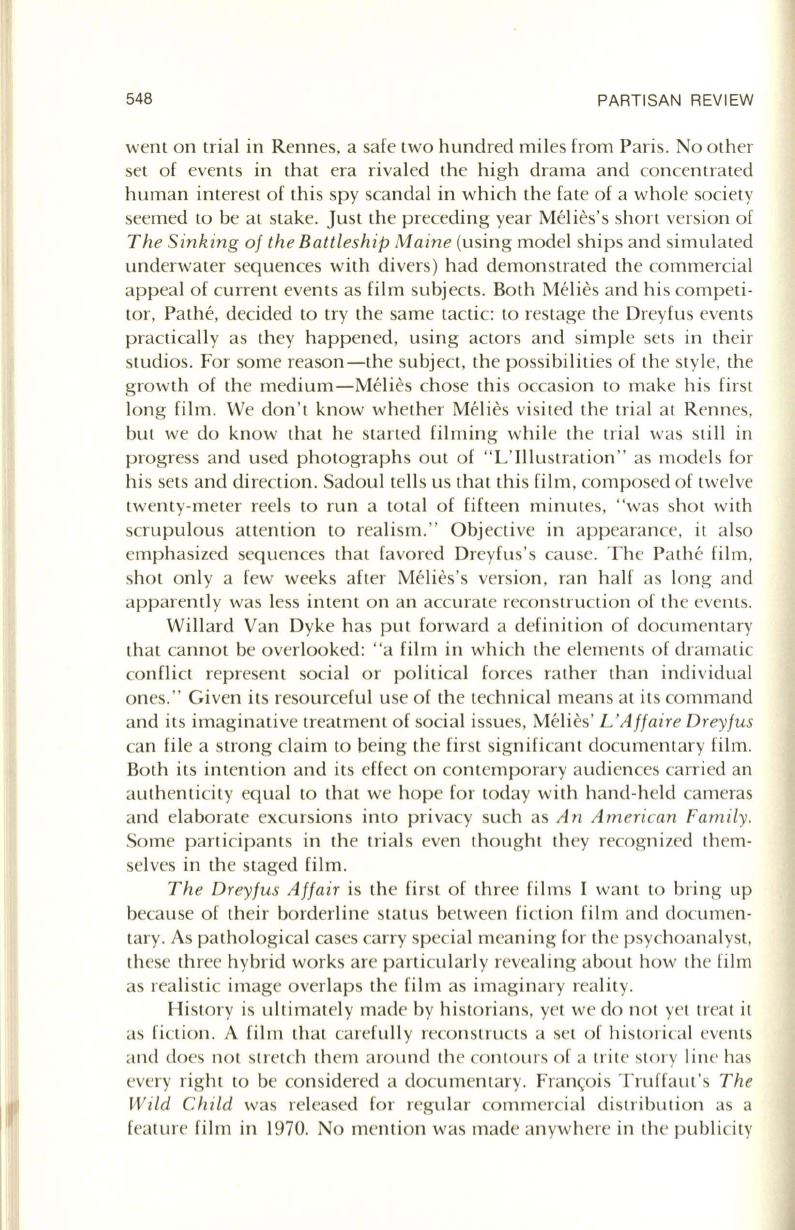
548
PARTISAN REVIEW
went on trial in Rennes, a safe two hundred miles from Paris. No other
set of events in that era rivaled the high drama and concentrated
human interest of this spy scandal in which the fate of a whole society
seemed to be at stake. Just the preceding year Melies's short version of
The Sinking of the Battleship Maine
(using model ships and simu lated
underwater sequences with divers) had demonstrated the commercial
appeal of current events as film subjects. Both Melies and his competi–
tor, Pathe, decided to try the same tactic: to restage the Dreyfus events
practically as they happened, using actors and simple sets in their
studios. For some reason-the subject, the possibilities of the style, the
growth of the medium-Melies chose this occasion to make his first
long film. We don't know whether Melies visited the trial at Rennes,
but we do know that he started filming while the trial was still in
progress and used photographs out of "L'Il\ustration" as models for
his sets and direction. Sadoul tells us that this film, composed of twelve
twenty-meter reels to run a total of fifteen minutes, "was shot with
scrupulous attention to realism." Objective in appearance, it also
emphasized sequences that favored Dreyfus's cause. The Pathe film,
shot only a few weeks after Melies's version, ran half as long and
apparently was less intent on an accurate reconstruction of the events.
Willard Van Dyke has put forward a definition of documentary
that cannot be overlooked: "a film in which the elements of dramatic
conflict represent social or political forces rather than individual
ones." Given its resourceful use of the technical means at its command
and its imaginative treatment of social issues, Melies'
L'Affaire Dreyfus
can file a strong claim to being the first significant documentary film.
Both its intention and its effect on contemporary audiences carried an
authenticity equal to that we hope for today with hand-held cameras
and elaborate excursions into privacy such as
An American Family.
Some participants in the trials even thought they recognized them–
selves in the staged film.
The Dreyfus Affair
is the first of three films I want to bring up
because of their borderline status between fiction film and documen–
tary. As pathological cases carry special meaning for the psychoanalyst,
these three hybrid works are particularly revealing about how the film
as realistic image overlaps the film as imaginary reality.
History is ultimately made by historians, yet we do not yet treat it
as fiction. A film that carefu lly reconstructs a set of historical events
and does not stretch them around the contours of a trite story line has
every right to be considered a documentary. Franc;ois Truffaut's
The
Wild Child
was released for regular commercial distribution as a
feature film in 1970. No mention was made anywhere in the publicity


